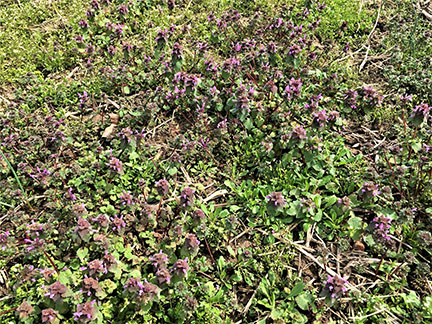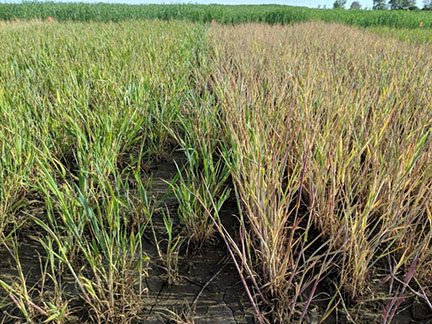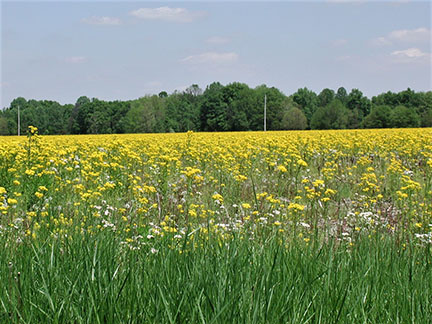There are many no-till fields across Indiana that have either not been burned down or those that will need to be sprayed again because of wet weather and planting delays. The wet weather this spring has kept sprayers out of the field and allowed winter annuals to continue to grow and the majority to go into reproductive growth (Figures 1 and 2). Those fields that did receive a burndown may need to be scouted and readdressed as many of the burndowns were applied under cool weather conditions, thus the herbicides were not effective in killing all the vegetation.

Figure 1. Mixed patch of marestail (horseweed), henbit, and purple deadnettle in the spring at burndown.
Farmers will need to have a plan as we approach any possible dry spell in which sprayers will be able to get back into the fields to make late burndowns. Winter annuals that are in reproductive stages and larger in growth are tougher to control and will require an increased rate of glyphosate for effective control. Rates of 1.25 to 1.5 lb ae glyphosate (35-42 fl oz Roundup Powermax) will be needed to effectively control winter annuals in fields that have yet to receive any burndown applications.
It is also recommended that farmers include 2,4-D (for Enlist soybean or corn), dicamba (for Xtend soybean and corn) and/or a saflufenacil product (Sharpen, Optill, Optill PRO, or Verdict) into the tank to improve control of the larger broadleaf weeds. Farmers may be inclined to remove these products from the tank due to plant back restrictions in a time when our planting season has become more compressed. Purdue weed scientists encourage farmers to NOT remove these products in order to achieve an improved burndown and assure that the field is clean at planting. We always discourage planting into dirty/weedy fields as herbicide options become much more limited once the crop emerges.
There will also be fields that need a second burndown application to clean up weeds that were not controlled by a previous burndown. In these fields, remember that plants need to be actively growing to achieve an effective cleanup burndown with a glyphosate based program. Farmers need to make sure surviving weeds have begun to regrow before the second burndown application is done to improve herbicide efficacy. Similar to what was mentioned above we encourage the use of at least 1.25 lb ae glyphosate and the inclusion of 2,4-D and/or Sharpen in the tank mix to improve burndown control.
Paraquat based burndown programs will be less effective for late spring burndowns if weeds are large, because effective spray coverage can be very difficult to achieve. If the wet weather prevented planting of a field that had been sprayed effectively in April, a paraquat based program can be effective on small, summer annual weeds. We would still encourage the use of metribuzin (soybean), atrazine (corn), saflufenacil (corn or beans) or 2,4-D or dicamba with paraquat to broaden the spectrum of activity if you are going after small, summer annual weeds. Although if farmers do choose to use a paraquat based program, they need to make sure to have a spray volume of at least 15 to 20 gal/A and apply with fine to medium droplets to achieve appropriate herbicide coverage.
Finally, we will address burndown of cover crops. Cover crop growth is proceeding at a rapid pace (i.e. they are gettin’ big!). As discussed earlier, use higher rates of glyphosate, add sharpen if needed (don’t’ mix with ATS to avoid antagonizing grass control), and consider adding residual herbicides. We almost always recommend adding a residual herbicide to a burndown mix when we are this close to planting. However, due to weather conditions this year, we must be careful about adding residual herbicides for a couple of reasons: 1) If the residual herbicide is sprayed onto large amounts of biomass, the residual may never hit the ground to do its job. 2) Residual herbicides sprayed under less than ideal weather conditions can antagonize glyphosate and reduce control of grasses (like wheat, cereal rye, annual ryegrass). This occasionally happens when herbicides such as flumioxazin, metribuzin, sulfentrazone, or atrazine are mixed with glyphosate (Figure 3). To avoid problems, increase the rate of glyphosate or spray the products separately. 3) 2,4-D or dicamba could be added if there are broadleaf species in the mix and you were planting the right soybean genetics (dicamba-Xtend or 2,4-D-Enlist) or planting corn.

Figure 3. Antagonism of atrazine with glyphosate (left) versus glyphosate alone (right) for cereal rye burndown (Photo credit: Wyatt Petersen).



